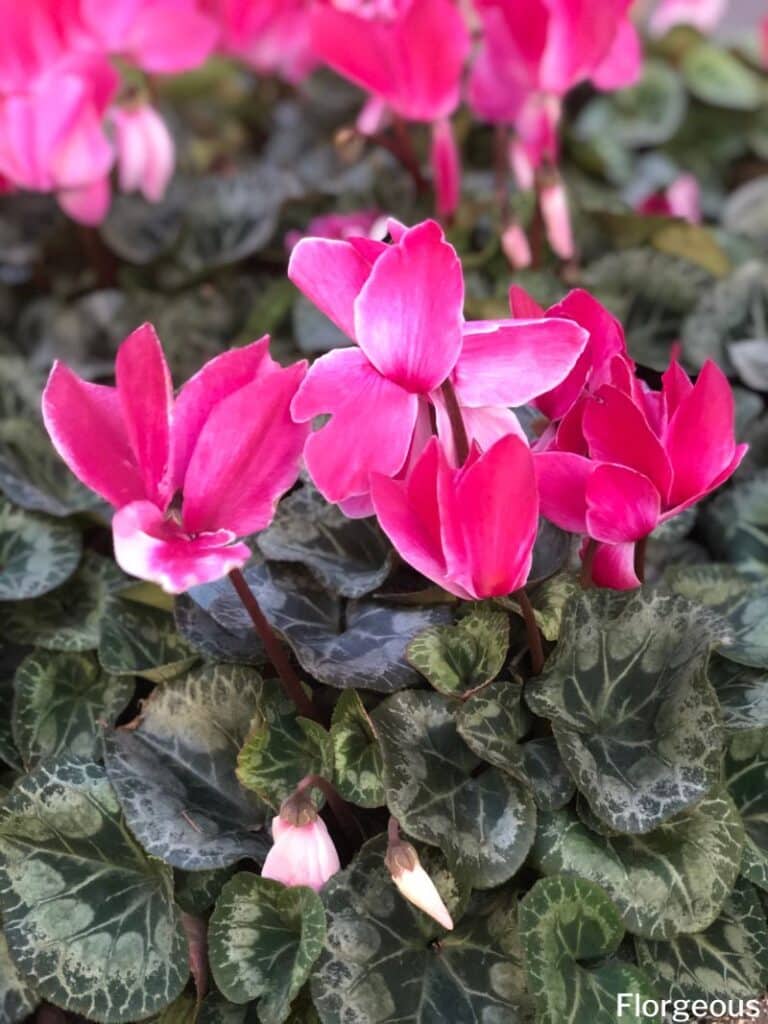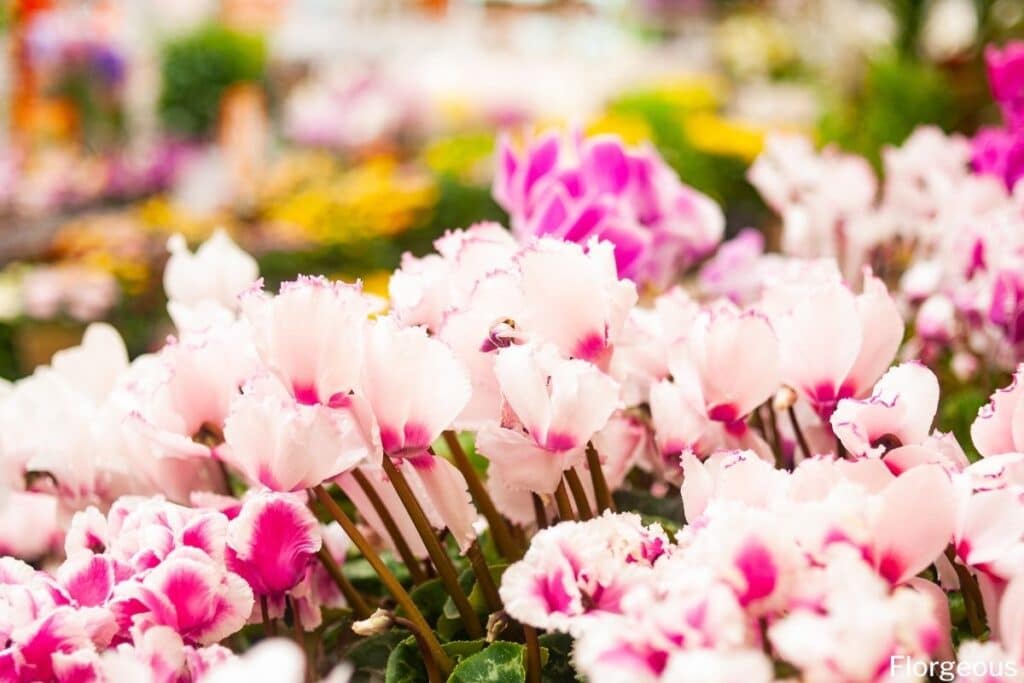Have you heard of the famous cyclamen plant and have wondered whether or not you should plant one to brighten your home or garden?
Luckily, there are many types of this species to choose from!
Every single type blooms beautiful flowers ranging from whites to shades of pinks, purples, and reds. Not only that, but a cyclamen’s flower shape changes between types as well. With a diverse history of origin, each cyclamen has a story. Some are native to Greece while others are native to Lebanon and Turkey.
Let’s jump right into some of the most common and beautiful cyclamen types.
Depending on your preferred aesthetic for the plant, your USDA Zone, and your preferred maintenance level, we have compiled a list of the most common types of cyclamen to choose from.

All of the types require a similar level of care, but some are more low maintenance than others. You can read our guide to learn how to care for cyclamen.
In addition, it is incredibly important to look up what USDA Zone you live in because there is a cyclamen variety for every zone!
1. C. alpinum
C. alpinium (also known as C. trochopteranthum) is a type of cyclamen that displays rounded or angular flowers that are deep pink or purple in color. The leaves are a vibrant green color that will add a nice touch to any area in your home or on your patio. In addition, the colorful blooms give off a light and lovely primrose scent.
If you live within USDA Zone 5 (northern states primarily in the midwest or east coast of the United States), then these regions are where the C. alpinium is at its hardiest. However, you can still grow this type outside of USDA Zone 5, but you need to pay careful attention to the temperature and watering amount. The Alpinum type thrives in partial shade, so it is best to keep them under your patio or in your household.
2. C. creticum
C. creticum displays heart-shaped or triangular flowers that bloom in white or reddish pink. The plant gives off a nice lily scent when in full bloom. Its flowering season is between the months of February to May while its foliage growing season begins in the winter months.
That being said, these plants thrive in USDA Zone 8 which includes parts of the West Coast, southern states like Texas, and some East Coast states like Florida, Georgia, South Carolina, and North Carolina.
This type usually finds itself near slightly wet environments which is rather unique. Because of their preferred environment, they can often be found near riverbanks, grasslands, and even old walls.
Unlike other types of cyclamen, the Creticum (also known as Cretan Sowbread) has a slow growth period. It can take many months for this type to gain size, so don’t be discouraged if you’re not seeing a ton of growth. When the Cretan Sowbread does gain size, the foliage can grow anywhere between 4-12 cm long and 3.5-12 cm wide.
3. C. coum
Also known as the Eastern Cyclamen, this type has no scent but has a variety of bright colors. The Cyclamen Coum’s flowers are usually white, pink, or dark magenta. The petals also seem to exhibit a “twisty” shape rather than rounded or triangular petals. Because of the vibrancy of this type’s magenta flowers, squirrels and other vermin may be more attracted to it.
The foliage is also bright in color (pale green to be exact) and would be a lovely addition to your home or garden.
Eastern Cyclamen is primarily found in Iran and Turkey, but you can still purchase this plant for your home. They grow best in USDA Zone 5 (midwest or east coast area) and can tolerate dry environments well. Make sure that the plant is located where it receives partial shade especially if you plant it outdoors.
These lovely plants aren’t prone to a ton of diseases particularly when they are planted outside. The most common diseases you should look out for are root rot and any grey molds, but even then this plant isn’t prone to diseases.
4. C. hederifolium
C. hederifolium (also known as ivy-leaved cyclamen or Neapolitan cyclamen) is a delicate types that have rounded, dark green leaves, and twisted white flowers. The cyclamen hederifolium requires some sort of shelter to shield it from full sun. During the autumn season, you will start to see the plant’s lovely blooms.
Ivy-leaved cyclamen thrive in USDA Zone 5 so they can withstand drier environments. They are known as the hardiest and easy-to-grow of all the types of cyclamen.
When the flowering time ends around late spring, the rich and deeply colored foliage makes for excellent ground cover. These flowering plants are perfect for brightening up borders to your garden or to be used as ground cover. However, it is known that this type can attract mice and other small vermin, so make sure to keep an eye out for any damage to these plants.
5. C. graecum
This cyclamen graecum is incredibly vibrant in color and fun in shape. Oval-shaped, bright green leaves complemented with bright pink or purple flowers that bloom in the autumn season are the perfect addition to any household. The flowers are twisted with pointed tips and can grow to be 15-25mm long.
However, C. graecum is a tad bit difficult to grow. It is best to keep the plant as a potted plant for your house, but it can grow outdoors if you prefer. It needs indirect sun while inside and partial shade when outside.
Because these flowering houseplants need a lot of care and attention, a low-nitrogen fertilizer is recommended to be distributed every few months to keep the plant vibrant and healthy. They originate from the southern mainland of Greece in addition to neighboring islands. Therefore, humidity and temperate weather are a must. Keep this in mind when choosing companion plants for cyclamen that have similar needs.
6. C. pseudibericum
This semi-hardy type of cyclamen has an extremely sweet scent accompanied by vibrant shades of pink or purple. The foliage is deep green with grey or white accents near the base. The flowers bloom from March to May and can reach 20-25mm long. In addition, the flowers kind of look like the ace of spades.
The total height of this plant can reach 5-10 cm but takes about 2-5 years to reach its maximum height. Cyclamen Pseudibericum is perfect for naturalizing. In other words, this plant is great for self-propagating. They prefer to be “left alone” when they are initially planted. Therefore, this plant can be found in rock gardens or containers.
7. C. repandum
A Cyclamen Repandum is a dwarf perennial that has heart-shaped, pink flowers. “Dwarf” plants are plants that remain very short and don’t grow tall. They are typically used as a groundcover because of their height. In terms of this type of cyclamen, it only reaches about 2cm in length. They also bloom in early spring which is much like all the other types of cyclamen.
These types grow well in USDA Zone 4 which is around northern midwest states and some northern states near the East Coast. Luckily, this means they don’t require a ton of cultivation in terms of fertilizing them, but still need some of the normal care. For example, this plant grows well in partial shade and should not be placed out in full sun.
8. C. persicum
This cyclamen is most commonly planted as a houseplant and a rather large one in fact (for the average size of the cyclamen species). The C. persicum can grow to just under one foot and has a light scent. They are low-maintenance plants but require nutrient-rich soil (low nitrogen is preferred). Their flowers are pink, red, violet, and white, and their leaves are dark green with white or silver accents.
These white blooms look great in indoor pots or containers under your patio. C. persicum blooms in winter and law dormant in the summer. Therefore, you do not need to water them during the summer. Mites can be a problem for this plant so keep an eye out for these pests.
In addition, C. persicum is harmful to both humans and plants. If you have any pets, make sure this plant is kept out of reach, and do not ingest the plant yourself.
9. C. libanoticum
This delicate type of cyclamen is lightly scented with light pink flowers. The C. libanoticum is a dwarf perennial much like the C. prepandum.
Therefore, this type can also be planted for ground cover within USDA Zone 8. However, this type of cyclamen is rare which was previously thought to be extinct. It was discovered again in Lebanon and has since then been carefully protected.
Leaves for this plant typically appear in the fall while its flowers tend to bloom at the beginning of March. This plant loves fertile soil with some humus. That being said, its seeds can be sown at any time, but the ideal temperature for the seeds to germinate would be around 10-15 degrees centigrade.
10. C. purpurascens
Cyclamen Purpurascens (Hardy Cyclamen) is a lovely type of cyclamen that is known for its delicate beauty and close-growing habit. This type of cyclamen grows best in cool, damp places with dirt that drains well. It is native to highland areas of Europe, like the Alps and the Carpathians.
This european cyclamen has pretty pink to purple flowers with petals that fall back, and the leaves are covered in complex patterns.
This hardy species, Cyclamen purpurascens, blooms from late summer to early fall and adds a splash of color to rock gardens, woods gardens, and shady areas. This purple cyclamen likes partial shade and grows slowly, which makes it a great choice for making shady parts of the yard more interesting.
FAQs
Are there two types of cyclamen?
Cyclamen persicum, commonly known as florist’s cyclamen or Persian cyclamen, is larger in size and typically grown as a houseplant or for outdoor gardens. It produces larger flowers and foliage compared to Cyclamen coum.
What is the difference between cyclamen and mini cyclamen?
Mini cyclamen usually refers to cultivars of Cyclamen persicum that have been bred to produce smaller plants with more compact growth habits. These mini cyclamen are often sold as potted plants for indoor decoration or as ornamental bedding plants.
What are the different colors of cyclamen?
Cyclamen flowers come in a variety of colors, including shades of white, pink, red, lavender, and purple. Some cultivars may also feature bi-colored or variegated flowers with contrasting markings or edges. Additionally, cyclamen foliage can range from solid green to variegated patterns of green and silver.
Conclusion
There are so many different cyclamen varieties that it’s hard to choose! Whether you like lightly fragrant or extremely sweet-smelling blooms, there is a cyclamen plant for that. In addition, this species of plant has so many different varieties of flowers. Twisted, heart-shaped, round, oval, and pointed petals adorn the species.
While selecting the cyclamen for you, make sure to keep your own USDA Zone in mind as well as the plant’s zone. This species is versatile, it’s just about finding the right type for your region.
Make sure to consult growing guides for each type as well. Although most types of cyclamens require the same kind of care and maintenance, there may be some small differences to take note of such as fertilizer necessity, sunlight, and pest/disease vulnerability.
Take your time picking out the cyclamen that’s right for you. All of these different types would make a beautiful addition to your garden or inside your home.
Don’t forget to check our guide on cyclamen symbolism to learn more about this plant.







